Baseball is more than just a game—it’s about the moments you create, the memories you make, and the gear that helps you do it all. Whether you’re playing with a trusted Wilson A2000, or just helped your little leaguer select their new A550, or sporting a classic Heart of The Hide, your glove deserves the best care to help it feel like home when you’re out there making plays. Breaking in your glove is more than a routine; it’s about creating a bond between you and your equipment that can last for seasons to come. Let’s take a closer look at why taking care of your glove matters and how to keep it performing at its best.

Why Your Glove Deserves the Best Care?
A baseball player’s glove stands out as something truly special. It’s not just equipment; it’s personal. The process of breaking in a glove isn’t just about preparing for the next play—it’s about shaping something that becomes an extension of who you are on the field. Before we dive into the techniques, let’s take a closer look at why this process matters and how it turns an ordinary glove into something extraordinary.
More Than Just a Glove
A baseball glove isn’t just a piece of gear—it’s your teammate, your go-to, the thing that feels like an extension of your hand when you’re out on the field. Breaking in a glove is more than just getting it comfortable; it’s about making it yours. The way it fits, the way it moves—it should feel like it’s been with you forever, even when it’s brand new. A well-broken-in glove gives you confidence and sticks with you for the long haul. It’s not just about making it game-ready—it’s about making it your glove.
Memories in the Making
For me, breaking in a glove has always been personal. I’ll never forget the times I spent with my dad, tossing a ball back and forth as he helped me break in my first glove. He’d show me how to work the leather, how to oil it just right, and he’d tell me why it mattered. It wasn’t just about the glove; it was about spending time together, creating memories that would last. Every time I stepped onto the field with that glove, it felt like I was carrying a piece of him with me. Those memories made every catch more meaningful.
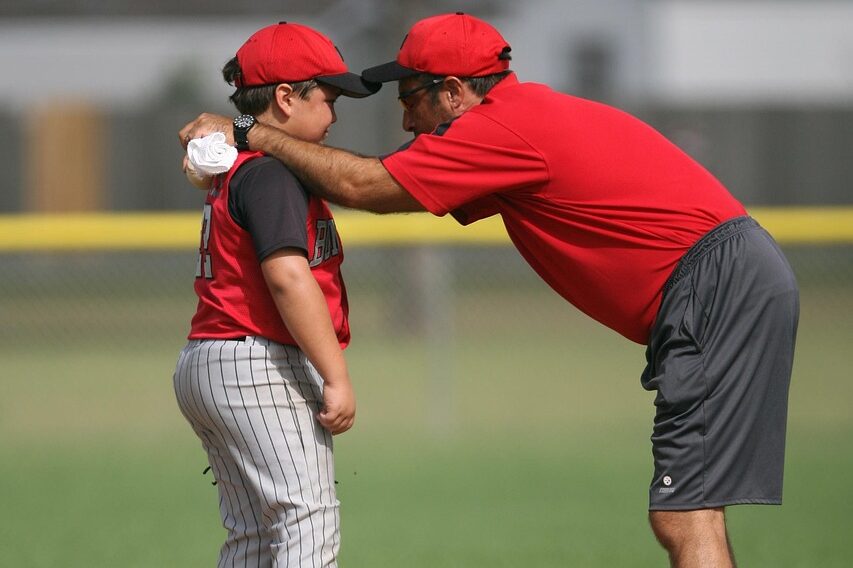
Making It Uniquely Yours
Breaking in your glove isn’t just a chore—it’s a chance to make it uniquely yours and, maybe, create a few memories along the way. Let’s dive into the best ways to do it, so your glove is ready for anything and everything the game throws at you.
Why Breaking in a Baseball Glove Matters?
When you first grab a brand-new baseball glove, it’s stiff and awkward, right? That’s because it’s made from tough leather that’s built to last, but it doesn’t yet have the flexibility needed for those quick, sharp moves on the field. Breaking in your glove softens the leather, making it more pliable and giving it the shape and fit that will feel natural to your hand. For me, it was always about getting that perfect fit—the one where the glove feels like an extension of your hand, ready to respond to every pitch, every catch. It’s not just about comfort; it’s about performance, too.
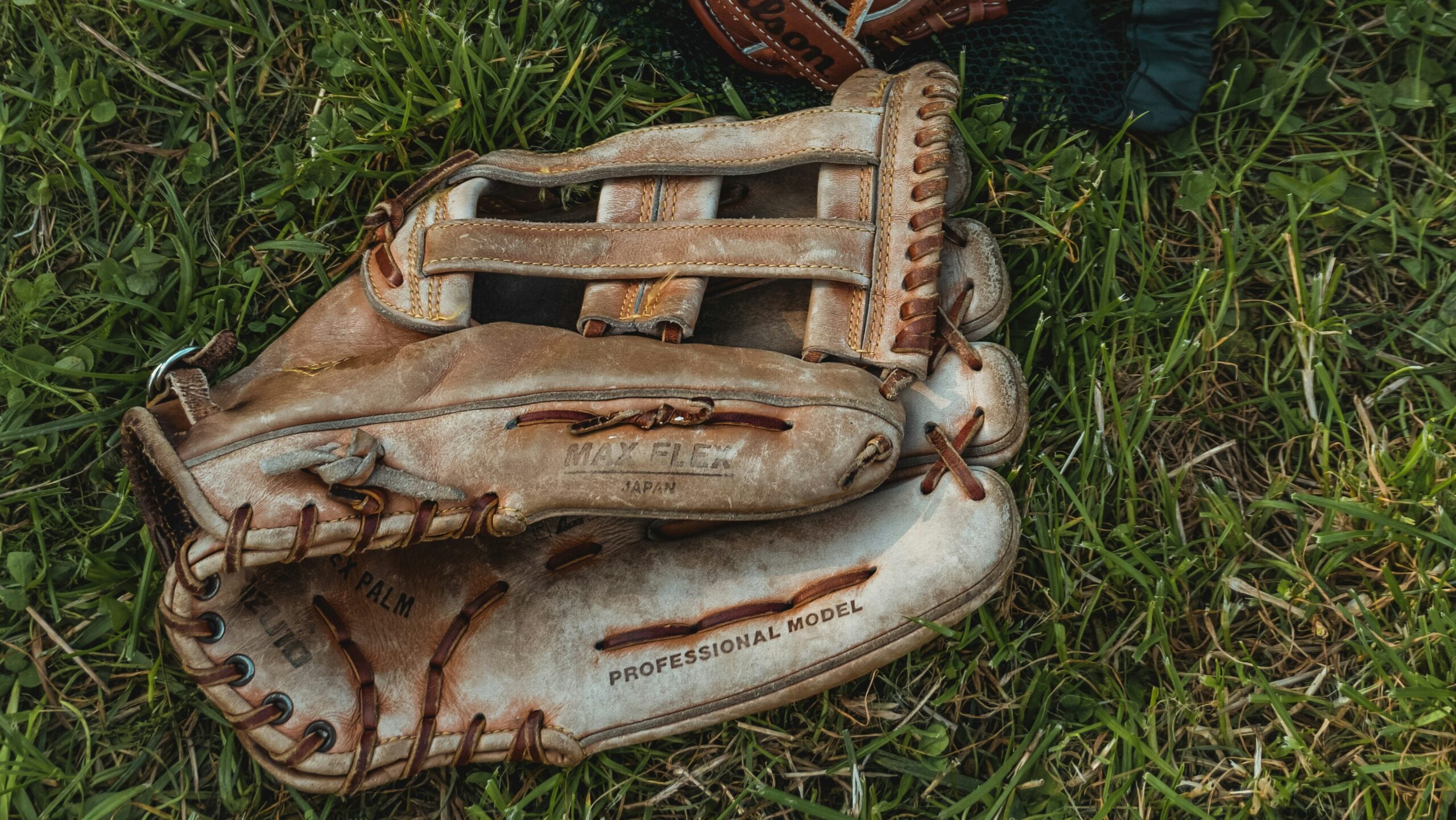
Leather vs. Synthetic Gloves
Leather Gloves: There’s just something about a leather glove that makes it feel like it’s part of you. Leather is durable, and with time, it molds to the shape of your hand, making it easier to grip and control the ball. I remember the first time I really broke in my first leather glove, how it started out so stiff at the first practice of the year and, over time, became something I could count on, something that fit me perfectly. It took a little longer to break in, but when it did, it felt like the glove had been waiting for me to get it just right.
Synthetic Gloves: Synthetic gloves are the opposite—lightweight and ready to go right out of the box. They’re great if you need something fast, but I’ve found that they don’t hold up as well over time. They don’t mold to your hand in the same way leather does, and they just don’t feel as “alive” when you’re playing. Synthetic gloves are great for your little leaguer when they’re just starting out.
Benefits of Breaking in a Glove
Improved Fit: The more you work with a glove, the better it fits. As the leather softens, it forms to your hand, and that’s when the magic happens. I remember how my glove started to feel like it knew me—how it moved with me instead of me having to fight against it. The grip improves, and suddenly, catching a ball feels like second nature.
Enhanced Performance: It’s not just about comfort. When your glove is broken in, it responds quicker. You’ll notice faster reactions, better ball handling, and just an overall ease in making those tough catches. It’s like you’re one with the glove. I noticed my performance improving as my glove softened. Every catch felt more natural, and I felt more confident on the field.
What Are the Best Methods to Break in Your Glove?
Breaking in a baseball glove is a personal experience that goes beyond just making it game-ready. It’s about molding the glove to fit your hand, creating a connection that makes it feel like a trusted teammate. While there are several methods to speed up the break-in process, some are more hands-on and rewarding than others. From playing catch to using tools like a glove mallet, each step is an opportunity to make the glove truly yours. Let’s dive into some of the best techniques that will help you shape your glove and make it feel like it’s always been a part of you.
Playing Catch (Traditional and Best)
Playing catch is hands down the best way to break in a glove, and honestly, it’s the most fun part of the process. There’s something special about the back-and-forth, feeling the ball hit the glove and watching it start to soften and shape with every catch. I’ve spent hours playing catch with my dad, and it wasn’t just about the glove—it was about making memories. The more you use the glove, the more it molds to your hand, becoming something that feels like it’s always been there.
One of the key things to focus on is shaping the pocket—the area where the ball sits when you catch it. The best way to do this is by catching balls in different spots of the glove: high, low, and in the middle. This helps create a more natural, even pocket that’s comfortable and effective. Using a regulation baseball helps target the pocket and the hinges (the areas that flex when you close the glove). Every time you catch, it’s like you’re working with the glove, making it your own.
Using a Glove Mallet
A glove mallet is a game-changer when it comes to breaking in a glove, especially if you want to speed things up without damaging it. It’s a great way to target the pocket and hinges, which are the areas that need the most attention. I remember using a mallet on my glove as a kid, and while it seemed like a small step, it really made a difference.
To use the mallet, start by placing a baseball in the pocket. Then, gently pound the glove, focusing on the pocket and the hinges. This helps the glove bend naturally and form the perfect shape. I made it a point to do this every day for a little while, and over time, it felt like the glove was breaking in faster. It’s a bit of extra effort, but it’s totally worth it when you feel the glove start to shape up just the way you want it.
Glove Wrapping
Glove wrapping is another simple yet effective way to break in your glove. I’ve used this method countless times, especially when I needed to give my glove a little extra push. Start by placing a baseball in the pocket and then wrapping the glove tightly with rubber bands. The ball will help shape the pocket, and the pressure from the rubber bands keeps it in place.
After wrapping, store the glove in a cool, dry place overnight. The next morning, you’ll notice the leather has softened a bit, and the pocket will have started to form. I always did this for a few days in a row, checking the glove after each session to see how much it had changed. It’s a simple trick, but it really works.
Light Use of Conditioners
Conditioners are another way to care for your glove and help it break in, but I always took it easy with them. A little bit of glove conditioner goes a long way in softening the leather and making it more pliable. I remember using just a small amount of conditioner, rubbing it into the glove with a cloth, and letting it sit for a bit. Too much conditioner can actually weaken the leather, so I always made sure not to overdo it.
Conditioners helped keep my glove soft and comfortable, but I never used them as a shortcut. It was always about balancing the care I gave the glove with the time it needed to truly break in. It’s about creating a relationship with your glove, one that lasts for years.
What Are the Faster Ways To Break In A Glove?
When you’re in a pinch and need to break in a glove fast, there are a few methods that can speed up the process without sacrificing the glove’s quality. Some techniques are quick and effective, like the hot water method or professional steaming, while others, like the “hot glove” method, bring back nostalgic memories of how I learned the process with my dad. Whether you’re trying to get your glove game-ready in time for practice or just looking for a way to speed things up, these methods can help get the job done. Let’s explore some of these approaches and how they can work for you.
Hot Water Method
The hot water method is another technique I’ve used over the years, and it’s especially useful when you need to break in a glove in a hurry. It’s a bit more hands-on, but it’s a method that gets results.
Start by heating some water—warm, but not boiling. You don’t want it too hot because you’re trying to soften the leather, not burn it. Pour the warm water evenly over the glove, making sure it’s covered but not drenched. The warm water will start to loosen the fibers of the leather, making it more pliable.
Once the glove is wet, it’s time to start shaping it. Begin by bending the glove in different areas, focusing on the pocket and the fingers. You can also gently pound the pocket with your hand or a mallet to help form it. I always took my time here, shaping the glove to fit my hand just right.
After you’ve shaped the glove, let it air dry naturally. Don’t rush it—let the leather dry slowly so it retains its strength. I’ve found that letting the glove dry at room temperature works best, and I always made sure to leave it out of direct sunlight or heat sources, as they can damage the leather. The result is a glove that’s soft, shaped to your hand, and ready to play.
Professional Steaming
If you’re in a rush or just don’t want to mess with the process yourself, many sports stores offer professional glove steaming services. This is a quick and effective way to break in your glove, especially if you need it ready for a game or practice right away.
The process involves the glove being steamed in a special machine, which softens the leather quickly and efficiently. The heat helps the glove mold to your hand, and it’s a great way to get a glove feeling comfortable in no time.
However, it’s important to be cautious. The downside of professional steaming is that excessive heat can weaken the leather if it’s not done properly. It’s easy for a machine to apply too much heat, which can lead to a glove that feels too soft or doesn’t last as long. If you go this route, make sure you trust the shop and ask about their process to ensure it’s done correctly. It’s a great method for urgent needs, but I always prefer a slower, more hands-on approach when I have the time.
Using Hot Glove to Break in a Glove
If you’re looking to break in a glove quickly and effectively, the “hot glove” method is a great option—and it’s something that’s been passed down through my family. My dad was the one who first showed me how to use this method, and it’s something I’ve carried on with my own son. Recently, we used it on his new Wilson A550, and it worked like a charm.
Here’s how it works: You start by applying a special hot glove treatment foam to the glove. This foam helps soften the leather, getting it ready for the break-in process. After the glove is evenly coated, preheat your oven to around 300 degrees Fahrenheit. Place the glove in the oven for about 4 minutes—just enough to warm it up and soften the leather, but not so long that it becomes too hot or dries out. The goal is to gently loosen the leather without damaging it.
Once the glove is out of the oven (and still warm), it’s time to start working it. This part always reminds me of the times my dad and I would break in gloves together—he’d show me how to bend, shape, and mold the glove while it was still warm, making it easier to form to your hand. With my son’s Wilson A550, I helped him shape the pocket and work the hinges, molding the glove into a perfect fit. The warmth makes the leather much more pliable, so you can really work it to fit the way you want it.
I’ve always loved this method for how quickly it works without compromising the glove. It’s a great way to get a new glove feeling game-ready, and it brings back memories of the times my dad and I spent working on gloves together. Now, I’m passing that knowledge down to my son, creating new memories with him while breaking in his glove.
Advanced Customization Tips
When it comes to breaking in a glove, it’s not just about making it feel comfortable—it’s about shaping it to work perfectly for your specific position on the field. Whether you’re chasing down fly balls in the outfield or turning double plays in the infield, your glove can be customized to help you perform at your best. Here are a few advanced tips to make your glove truly yours.
Position-Specific Shaping
Outfielders: If you play in the outfield, you know that having a deep pocket is essential for securing those high, tricky fly balls. A deeper pocket gives you more room to catch and hold onto the ball, especially when you’re making a running catch or trying to track down a long hit. To break in your glove for outfield play, focus on creating a deeper pocket by catching balls in that area and using a mallet to gently shape it. This will help your glove feel more secure and ready to handle anything that comes your way.
Infielders: Infield gloves need to be a bit more nimble. For quick transfers and fast throws, a shallower pocket is key. A shallow pocket allows you to get the ball out quickly, whether you’re scooping up a grounder or getting ready to turn a double play. To shape your glove for infield play, focus on the pocket’s depth by bending the glove at the fingers. This will make it easier to scoop and transfer the ball quickly, which is critical when you’re trying to make a fast play.
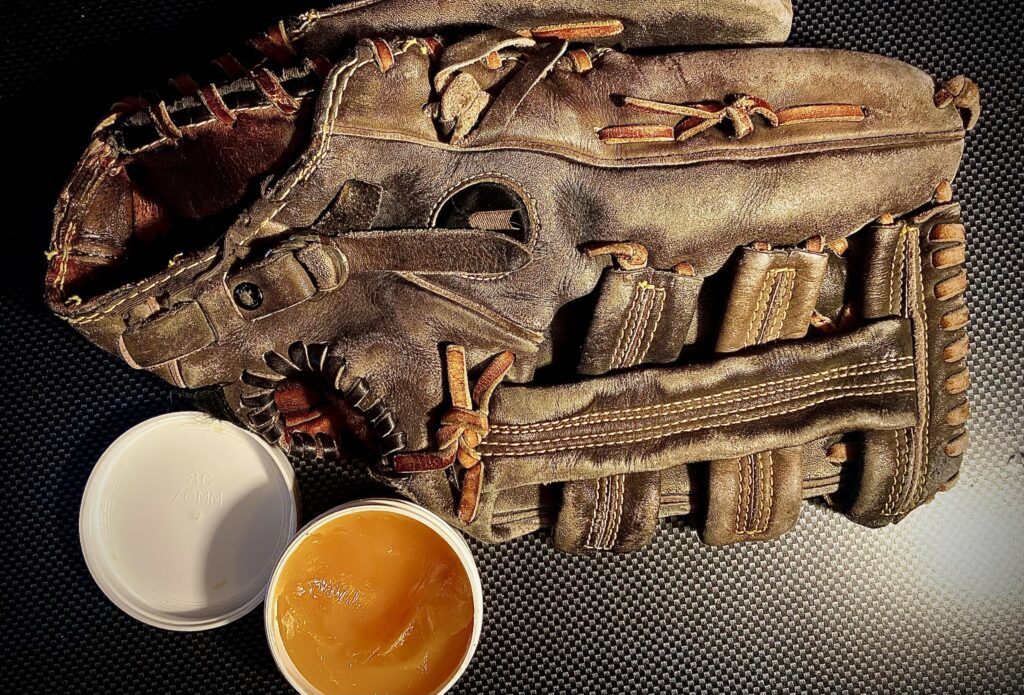
Flare and Alignment
Flare: The flare of the glove refers to how the fingers are angled outward. This gives the glove a wider opening, which is especially helpful for infielders who need quick access to the ball. A wider flare means you can grab the ball more easily and make a smoother transition from glove to throw. To create the right flare, gently bend the glove at the base of the fingers and use a mallet to shape it outward. The more you use it, the more this flare will naturally develop, making it easier to scoop up balls quickly.
Thumb and Pinky Alignment: The way your thumb and pinky are aligned in the glove can really affect how it feels when you close it. If you want more control, try bringing the thumb and pinky closer together. This gives you a firmer grip, which is useful when you need to secure the ball quickly. If you prefer more flexibility, loosening the alignment can help. It’s all about finding the right balance between comfort and control, and a few tweaks to the thumb and pinky alignment can make a big difference in how your glove performs.
Fine-Tuning Fit with Laces
Laces aren’t just for holding the glove together—they’re a great tool for adjusting the fit and feel of your glove. By tightening or loosening the laces around the wrist, fingers, and pocket, you can customize how the glove fits and responds to your hand. For a more secure fit, try tightening the laces around the wrist. This will give you more control, especially when you’re making fast movements. On the other hand, loosening the laces around the pocket can give you more flexibility, which can make the glove feel more comfortable if you’re looking for a looser fit.
Taking the time to fine-tune your glove’s fit and shape can really elevate your game. These customization tips let you make the glove your own, adjusting it to suit your playing style and position on the field. After all, your glove is more than just gear—it’s a trusted teammate, and it should work as hard as you do.
How To Keep My Glove Game-Ready?
Taking care of your glove is about more than just getting it broken in—it’s about making sure it stays in top shape so you can rely on it season after season. Just like any good piece of gear, a little TLC can go a long way in extending its life and keeping it performing at its best. Here are a few simple but important ways to keep your glove game-ready, year after year.
Seasonal Care
At the end of each season, it’s a good idea to show your glove some love. After all, it’s been through a lot of action, and it deserves a little rest and recovery. Start by lightly oiling the glove to keep the leather soft and prevent it from drying out. Don’t go overboard—just a thin layer of glove oil or conditioner will do the job. This helps maintain its flexibility and prevents cracks, especially if the glove’s been exposed to a lot of sun or heat during the season.
Also, take a moment to check the laces. I’ve learned the hard way that worn-out laces can ruin a glove’s performance. If you see any fraying or loose laces, it’s worth replacing them before the next season starts. This way, you won’t be caught off guard during a game when a lace snaps or comes undone.
Storage Tips
How you store your glove is just as important as how you care for it during the season. After the game or practice, always store your glove in a cool, dry place. Don’t leave it in the car or anywhere it could get too hot or humid. I used to leave mine in the trunk after a game, but I quickly learned that the heat and humidity can damage the leather over time.
To keep the glove’s shape, I always put a baseball in the pocket when I’m not using it. This helps the glove retain its curve and prevents the pocket from collapsing. If you want to take it a step further, you can use a glove form or wrap it up with rubber bands to keep everything in place. Just be sure to store it in a breathable bag or a well-ventilated area to avoid mold or mildew.
Longevity Tips
If you want your glove to last, a little regular cleaning and conditioning goes a long way. After a few practices or games, I’ll take a soft cloth and wipe down the glove to remove any dirt or sweat. This keeps the leather clean and prevents grime from building up and breaking it down over time. Just make sure it’s dry before you store it, so you don’t trap moisture in.
Conditioning is another must. Every few months, I apply a small amount of glove conditioner to keep the leather soft and flexible. It helps the glove stay pliable and comfortable without getting too stiff or brittle. But remember, less is more—too much conditioner can make the glove too soft and affect how it performs. Regular care like this will keep your glove in top shape and ready to perform whenever you need it.
Taking care of your glove doesn’t take much, but it makes a big difference. With a little attention at the end of the season and throughout the year, you’ll ensure your glove stays in the best shape possible and is always ready for the next play.
Final Thoughts – The Perfect Glove Takes Patience
Taking care of your glove is about more than just maintaining its shape—it’s about creating a relationship with it that lasts. Whether you’re working with a Wilson A550, a Wilson A2000, or a Heart of The Hide, each glove deserves the time and care it takes to become a true extension of your hand. From the moment you start breaking it in to the routine maintenance you do each season, your glove is there to help you make memories on the field. By following the right steps and using the best techniques, you’ll ensure that your glove stays in top shape and ready for every game, every play, and every moment that comes your way.


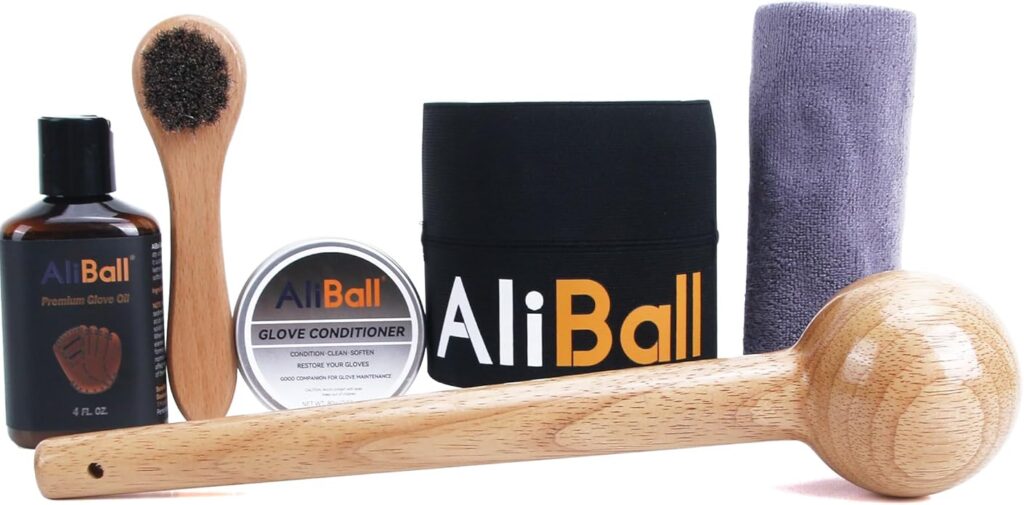
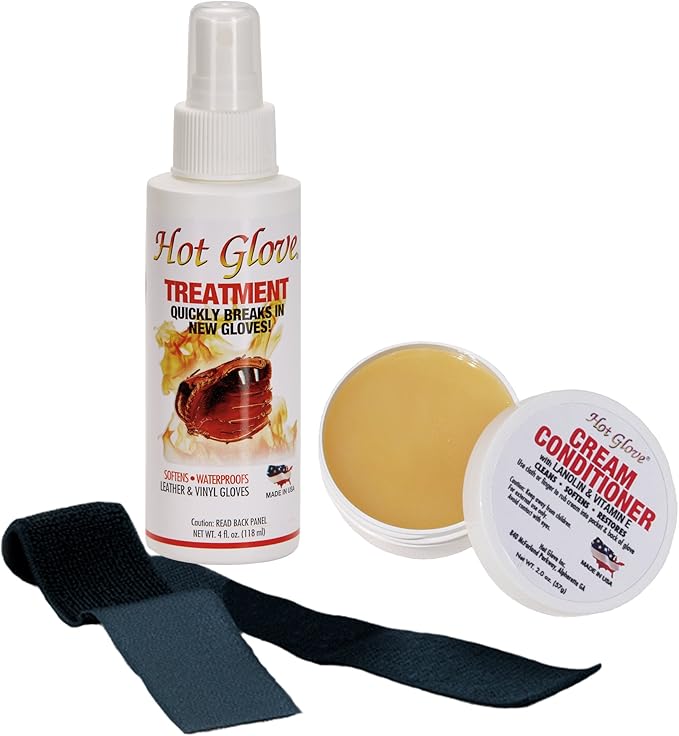
Hi Zachary,
I read your article about breaking in and taking care of a baseball glove, and I wanted to let you know how much it meant to me. Your article was super easy to understand and had a lot of great tips. I liked how you explained the different ways to soften the glove, like using oils and mallets, and how to shape it by putting a ball inside. It’s cool to know that these steps can help the glove fit better and last longer.
I also appreciated the advice on when it’s time to get a new glove. It can be tough to let go of a glove that has a lot of memories, but you made it clear that sometimes it’s necessary to keep playing your best.
Most of all, I loved how your article showed that breaking in a glove is about more than just getting it ready for the game. It’s a special tradition that brings people together and creates lasting memories, especially between kids and their parents.
It’s awesome that you’re sharing this knowledge with others so they can experience the same joy and connection through baseball.
Thanks for writing such a great article. Keep up the amazing work!
All the Best,
Eric
Thank you so much for your heartfelt comment—it really means a lot! I’m so glad you found the article helpful and easy to follow. Breaking in a glove is such a meaningful process, and I love that you connected with the idea of it being more than just prepping gear for a game. It’s a tradition that really does bring people together, and it’s awesome to hear that resonated with you.
You’re absolutely right—letting go of a glove with so many memories can be tough. But knowing it’s part of keeping yourself or your child playing their best makes it a little easier. And it’s great to think about all the new memories a fresh glove will create!
Thank you for taking the time to share such kind words. It’s comments like yours that make writing about baseball so rewarding. Wishing you lots of joy and connection through the game—both on and off the field! ⚾
I really appreciate how you laid out the process of breaking in a baseball glove and caring for it in such clear and practical steps. The featured image looks like one of my first gloves from about 1962. The section about different methods for breaking in a glove, like using oil or steaming, was especially interesting—I had no idea there were so many options! I also liked your tips on regular maintenance to keep the glove in great shape over time.
Thank you so much for your thoughtful comment! I’m glad you found the breakdown of the glove break-in process and care helpful—it’s always rewarding to know the tips resonate with readers.
How amazing that the featured image reminded you of one of your first gloves from 1962! There’s so much nostalgia tied to baseball gloves, and it’s incredible how they can bring back those early memories of playing the game.
I’m happy you enjoyed learning about the different break-in methods—there’s definitely more to it than most people realize! And regular maintenance really is key to keeping a glove in good shape for years to come. If you ever have questions or want to share more about your glove journey, I’d love to hear about it. Thanks again for reading and sharing your thoughts! ⚾
The article provides a comprehensive guide to breaking in and maintaining a baseball glove. He explains various methods, including traditional playing catch, steaming the glove and using the glove with a mallet. It also gives tips on using oils and conditioners, as well as what to avoid, like the microwave. Overall, the guide is useful for players of all levels.
Thank you for your thoughtful comment! I’m glad you found the guide comprehensive and useful. It’s always great to hear that the different methods and tips resonated with you, especially when it comes to maintaining a glove the right way. I try to cover all the bases, from traditional techniques to things to avoid, like microwaving, to ensure players of all levels can keep their gloves in top shape. Appreciate your feedback!
It masterfully combines the sentimental and practical sides of breaking in and caring for a baseball glove. The personal story about bonding with a late father through this tradition adds a touching, nostalgic layer that resonates deeply. At the same time, the article provides clear and actionable steps for breaking in, maintaining, and eventually replacing a glove, ensuring it performs at its best. The blend of emotion and expertise makes this piece both relatable and valuable for players of all levels, celebrating the enduring connection between players and their gloves.
Thank you so much for your kind words! I’m really glad the article resonated with you on both a sentimental and practical level. For many of us, a baseball glove is more than just equipment; it’s a symbol of memories and growth. I’m happy to hear the tips on breaking in and maintaining the glove were helpful too. That balance between emotion and expertise is something I strive for, so I appreciate your feedback!
Im far from a good baseball player, but I can imagine a player’s glove being one of the most important tools in the trade. Not to get too off topic but I like to compare it to when gun safety instructors tell me that “the firearm should be thought of as an extension of my arm.” I guess its more like breaking in a good pair of shoes only the leather is finer. It’s awesome how much detail comes into the make up and maintenance of the glove. Makes me appreciate the majors more. Wonder how many times those guys change gloves. I bet catchers have whole wine cellars of gloves for themselves. Anyone know?
You’re absolutely right—just like a good pair of shoes, a baseball glove becomes an extension of the player’s body. Major League players are very particular about their gloves, and while some might stick with one glove for an entire season, others switch them out more frequently, especially if they’re worn out or lose their shape. Catchers, in particular, often go through several gloves a season due to the intense wear and tear. Some even keep a small collection to rotate depending on the game or their needs—definitely not a “wine cellar,” but close!
I really enjoyed your article on breaking in and caring for a baseball glove! It brought back memories of my own experiences with new gloves. I remember the excitement of getting a fresh glove, but also the challenge of making it game-ready. Playing catch with friends was always my go-to method; there’s something special about forming that bond with the glove through practice.
Your tips on using warm water and a mallet are spot on! I’ve tried those methods too, and they really do help soften the leather. However, I found that the best way to truly break in a glove is just to use it as much as possible. The more you catch with it, the more it molds to your hand, making it feel like an extension of yourself.
Have you ever experimented with different oils or conditioners for maintaining the glove? I’ve heard mixed opinions on that, and I’d love to know what works best for you!
Hey Maxon!
I’m so glad the article brought back those memories! I completely agree that the best way to break in a glove is through consistent use. Over the years, I’ve tried various methods, and the combination of warm water, a mallet, and plenty of catch sessions always worked best for me. As for oils and conditioners, I’ve used a few, but I prefer a lighter oil like mink or a dedicated glove conditioner. Too much can make the leather too soft, but just the right amount helps maintain flexibility without compromising structure. It’s all about balance!
I never realized that one had to break in a baseball glove just like a ballerina needs to break in her pointe shoes for better performance and comfort. I see it is also quite a process and it takes time to get the glove to mold to your hand. What is the best material to use for these gloves. Would you say leather or is there another option?
Hi Michel,
Good point, just like ballet shoes, a glove needs time and care to mold to your hand for optimal performance. Leather is traditionally the best material for baseball gloves, offering durability, flexibility, and a natural feel. However, some gloves are made with synthetic materials, which can be more lightweight and require less breaking in. But for long-term performance and comfort, high-quality leather is generally the top choice.
Hi Zachary,
I wanted to express my appreciation for your articulate and meaningful article. Even though I’m not athletic and have never played baseball, I found it incredibly informative and easy to follow. I had no idea there were specific techniques to maintain a leather glove, especially the methods to break it in.
I understand that leather, much like a quality shoe or purse, requires proper maintenance to last a long time. With the right tools and care, it can be preserved for years. You’ve provided valuable insights on how to soften, shape, and maintain a leather baseball glove, making it a cherished item for years to come.
I do have a question, though. When a cherished leather glove is damaged or in need of repair, can it be taken to a repair shop to be refitted, revived, or reshaped for the next user, perhaps for another child? For instance, if a father wanted to pass down his boyhood glove to his son, can it be refitted and revived? Are leather gloves typically revived, repurposed, or simply discarded after many uses?
I look forward to hearing your thoughts on this.
Hi Cydney,
Thank you so much for your thoughtful feedback! I’m glad to hear the article resonated with you, even though baseball isn’t your primary interest. As for your question, yes, leather gloves can often be repaired and reshaped. Many professional glove repair services can restore a well-loved glove, from re-lacing to re-shaping the leather. It’s a great way to pass down a cherished item, and with the right care, a glove can be revived for the next user, whether it’s a child or a future generation.
Thanks again for reaching out!
-Zac
What a beautifully written post! I love how you highlight that breaking in a glove isn’t just about functionality but also about creating memories and bonding. That image of playing catch with your dad really hits home—it’s such a timeless tradition that goes beyond the game itself. The care tips are spot on, too. I never realized how much a little conditioning and proper storage could extend a glove’s life, but it makes perfect sense. It’s amazing how something as simple as a baseball glove can carry so much history, personality, and emotion. Thanks for sharing such a thorough and heartfelt guide! It’s a great reminder that even the smallest rituals can mean so much.
Thank you so much for your kind words! I’m thrilled that the post resonated with you, especially the part about creating memories—it’s something I hold close to my heart. Playing catch really is such a simple yet meaningful tradition, and I love that it’s timeless for so many of us. I’m glad the care tips were helpful, too! A well-loved glove truly does carry so much history and personality. Thanks for taking the time to share your thoughts—it’s comments like yours that make writing about these moments so rewarding!